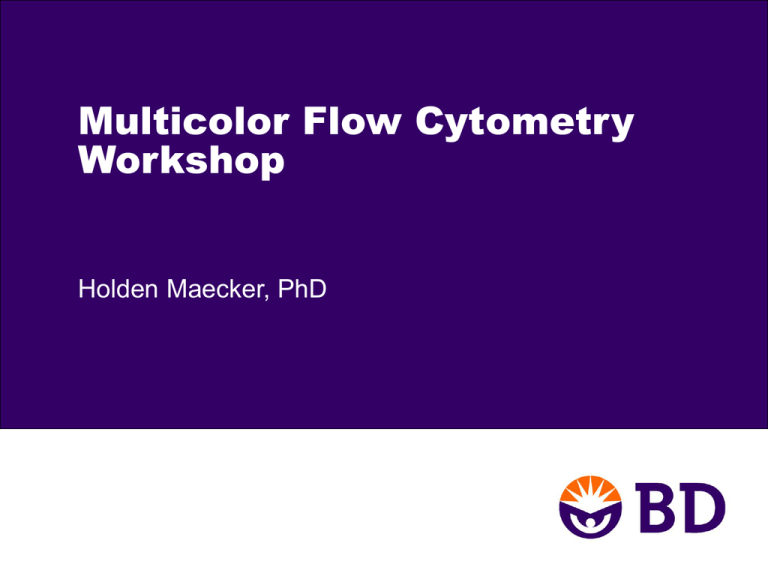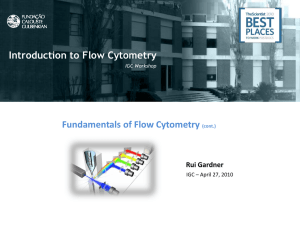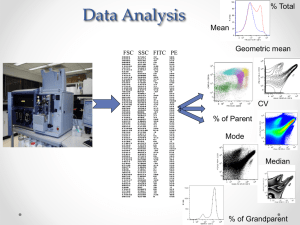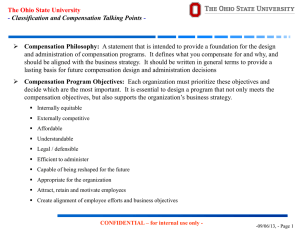Multicolor course-HTM - Maeckerlab Weblog
advertisement

Multicolor Flow Cytometry Workshop Holden Maecker, PhD Learning Objectives • Explain the critical aspects of digital and multicolor flow cytometry that make it different from traditional analog flow cytometry with 1–4 colors • Describe the role of instrument configuration in the performance of multicolor flow cytometry • Perform instrument QC using BDTM Cytometer Setup and Tracking beads, and understand the use of baseline and application settings in BD FACSDivaTM software • Design a robust multicolor reagent panel, understanding the role of spillover, tandem dyes, and antibody titration • Create appropriate controls for a multicolor experiment, and be able to find and correct potential problems in multicolor data Schedule: Day 1 9:00–10:30 I. Introduction, review of basic concepts 10:30–10:45 Break 10:45–11:45 II. Digital and multicolor flow cytometry Exercise 1: Adjusting biexponential displays 12:00–1:00 Lunch 1:00–2:00 III. Instrument setup, optimization, and QC Exercise 2: Determining stain index and spill index 2:00–4:00 Acquisition of data: • • • • Instrument characterization using CS&T Baseline and application settings determination Compensation using BD™ CompBeads 8-color stained PBMCs Schedule: Day 2 9:00–10:00 IV. Design and optimization of multicolor panels: • Selection of fluorochromes • Matching fluorochromes with antibody specificities • Determining application-specific settings Demonstration: Visualizing data on a virtual cytometer 10:00–12:00 Data analysis in BD FACSDiva software 12:00–1:00 Lunch 1:00–2:30 V. Controls and Data QC Exercise 3: Finding and correcting a spillover problem 2:30–2:45 Break 2:45–4:00 Review and summary, discussion of participant issues Multicolor Flow Cytometry Workshop: I. Review of Flow Cytometry Basics Outline • Definitions, what can be measured by flow cytometry • Fluidics: Sheath and sample streams, flow cells, sorting • Optics: Lasers, filters • Electronics: PMTs, signal processing • Fluorochromes: Spectra, spillover • Data analysis: FCS files, gating, statistics Definitions • Flow cytometry: The study of cells as they move in fluid suspension, allowing multiple measurements to be made for each cell. • FACSTM: Fluorescence-activated cell sorting What Measurements Can Be Made? • Forward scatter (FSC): Proportional to cell size • Side scatter (SSC): Proportional to cell granularity • Fluorescence: - Binding of fluorescent-labeled antibodies Ca++-sensitive dyes within cells Fluorescent proteins expressed by cells Binding of DNA dyes Scatter Profile of Lysed Whole Blood 400 600 Granulocytes Monocytes 200 Side Scatter 800 1000 Largest and most granular population Lymphocytes 0 Smallest and least granular population 0 200 400 600 800 Forward Scatter 1000 Negative control histogram PE Number of Events Fluorescence Data Display FITC Fluorescent Intensity FITC Major Components of a Flow Cytometer • Sample injection port • Sheath and waste reservoirs • Flow cell • Laser(s) • Optical filters • Photomultiplier tubes ( PMTs ) or photodiodes • Signal processor Cytometer Fluidics Create Laminar Flow Flow cell Sample stream Sheath stream Laser beam Cell Cell Sorting Multicolor Experiment Cytometer Configuration Longpass filter Bandpass filter PMT Background and Autofluorescence All cells have a certain level of background fluorescence due to: • Autofluorescence from pigments and fluorescent moieties on cellular proteins • Non-specifically bound antibodies and free antibody in the sample stream The level of autofluorescence varies with the wavelength of excitation and collection: • Highest in FITC, PE detectors • Lowest in far red (APC, Cy™7) detectors Fluorescence Sensitivity Detection Efficiency (Q): The number of photoelectrons generated per molecule of fluorophore • Dependent upon fluorophore, laser, filters, PMT sensitivity, voltage gain setting, etc. Background (B): Non-specific signal intrinsic to the system • Dependent upon autofluorescence, unbound fluorophore, ambient light, etc. Common Fluorophores for Ab Conjugation FLUOROCHROME Type of molecule Typical excitation laser Approximate emission peak Fluorescein isothyocyanate (FITC) Small organic 488 nm 518 nm Alexa Fluor® 488 Small organic 488 nm 518 nm Phycoerythrin (PE) Protein 488 or 532 nm 574 nm PE-Texas Red® Protein tandem 488 or 532 nm 615 nm PE-Cy™5 Protein tandem 488 or 532 nm 665 nm Peridinin chlorophyll protein (PerCP) Protein 488 or 532 nm 676 nm PerCP-Cy™ 5.5 Protein tandem 488 or 532 nm 695 nm PE-Cy™ 7 Protein tandem 488 or 532 nm 776 nm Allophycocyanin (APC) Protein 633 nm 659 nm Alexa Fluor® 647 Small organic 633 nm 667 nm Alexa Fluor® 700 Small organic 633 nm 718 nm APC-Cy™ 7 or APC-H7 Protein tandem 633 nm 784 nm Pacific BlueTM Small organic 405 nm 454 nm AmCyan Protein 405 nm 487 nm Fluorescence Spillover Emission of FITC in the PE channel Compensating for Spillover Uncompensated Uncompensated Compensated Compensated FITC mean fluorescence ---------------------------Negative Positive -------------------125 3,540 125 3,560 PE mean fluorescence ---------------------------Negative Positive -------------------185 1,650 135 135 1,650 – 185 % Spillover = X 100 3,540 – 125 FCS Files • FCS 2.0 and FCS 3.0 conventions • Often referred to as list-mode files • Contain all of the measurements (FSC-H, FSC-A, SSC-H, SSC-A, FL1-H…) for each individual cell processed in a given sample Hierarchical Gating Web Reference Tools • BD Spectrum Viewer: www.bdbiosciences.com/spectra • Maecker lab weblog: http://maeckerlab.typepad.com (protocols, manuscripts, literature updates) Multicolor Flow Cytometry Workshop: II. Digital & Multicolor Flow Cytometry Differences From Analog Instruments • Optics: Fiber optics and octagons/trigons • Fluidics: Optimized for high flow rates • Electronics: Digital signal processing PMT Octagon and Trigon PMT Bandpass filter Longpass filter Filter Nomenclature Conventions Longpass (LP) filter: Allows light above a certain wavelength to pass, reflects shorter wavelengths • Example: 505 LP = 505 nm longpass Bandpass (BP) filter: Allows light within a certain range of wavelengths to pass (above and below a specified midpoint) • Example: 530/30 BP = 515–545 nm bandpass Effect of Flow Rate • Higher flow rates mean a broader sample stream ( less precise focusing) • Less precise focusing means less accurate fluorescence measurement of dim populations ( population spreading) • Higher flow rates also increase the frequency of coincident events (can be gated out based on FSC area vs height) • In practice, flow rates of 8,000–12,000 events per second are acceptable on the BD™ LSR II (vs 2,000–3,000 events per second on a BD FACSCalibur™ flow cytometer) Digital Signal Processing Generates high resolution fluorescence values that can include negative numbers • No compression of populations at the low end of the fluorescence scale • More accurate representation of dim populations Allows compensation to be performed in the software at any time • Uncompensated data and any associated compensation matrix are both stored • Compensation can be changed at any time Peak area and peak height can both be recorded for all parameters Biexponential Display of Digital Data Uncom pe ns ate d 10 5 10 A Com pe ns ated 10 5 4 10 4 10 3 10 3 10 2 10 2 Antibody capture beads stained with 3 levels of an APC reagent B APC-Cy7 Area Log 10 1 10 1 10 Bie xp 10 5 10 4 10 3 1 10 2 10 3 10 4 10 5 C All populations align correctly 0 10 10 5 10 4 1 10 2 10 3 10 4 10 5 D 10 3 0 0 10 3 10 4 10 5 APC Area 0 10 3 10 4 10 5 The transformed display shows aligned populations In the APC-Cy7 dimension Spillover Affects Resolution Sensitivity Without CD45 AmCyan With CD45 AmCyan CD19 FITC Conclusions • Optical platforms using octagons and trigons result in more efficient light collection and flexibility in the use of detectors and filters • BD LSR II fluidics allow running at higher flow rates with minimal compromise to the data • Digital signal processing provides more accurate representation of dim populations, and more accurate and flexible compensation—but logarithmic data display may not be appropriate • More colors mean more spillover issues, with loss of resolution sensitivity in affected detectors Exercise 1 Adjusting biexponential displays: 1. Open the FCS file “exercise1.fcs” 2. Gate on small lymphocytes, then on double-positive events for CD45 AmCyan vs CD3 Pacific Blue 3. From this gate, create a plot of CD4 FITC vs CD8 APC-H7 4. Turn on biexponential scaling for the x- and y-axes, and note the changes to the plots 5. Turn on manual biexponential scaling and experiment with various scaling factors for FITC and APC-H7, noting how the plots change Questions: 1. Would gating be affected by biexponential scaling? 2. Is it important to use the same scaling for all samples in an experiment? Multicolor Flow Cytometry Workshop: III. Instrument Setup and QC Outline 1. Configure your instrument 2. Characterize your instrument 3. Design your panel 4. Optimize settings for your panel 5. Run appropriate controls 6. QC your data Outline 1. Configure your instrument • • • Number and type of lasers Number of PMTs per laser Choice of filters and dichroic mirrors These choices will determine: • • What fluorochromes you can use effectively How well certain fluorochrome combinations will perform How Do We Measure Performance? Resolution Sensitivity D W1 W2 Stain Index = D / W Where D = difference between positive and negative peak medians W = 2 x rSD (robust standard deviation) An Example: Green vs Blue Lasers • Green laser is more efficient for PE and PE tandems • Blue laser is more efficient for FITC, PerCP, and GFP CD127 PE 40 Stain index 35 30 25 mW green laser (532 nm) 25 100 mW blue laser (488 nm) 20 25 mW blue laser (488 nm) 15 10 5 0 300 400 500 600 700 PMT voltage Second Example: Filters and Spillover Outline 2. Characterize your instrument • • Obtain minimum baseline PMT settings Track performance over time This allows you to: • • Run the instrument where it is most sensitive Be alert to changes in the instrument that might affect performance Automated Baseline PMT Voltage Determination Using BD CS&T Baseline PMTV is set by placing the dim bead MFI to equal 10X SDEN 460 V SDEN = 20 MFI = 200 Performance Tracking A variety of parameters can be tracked: • Linearity, CVs, laser alignment • PMT voltages must hit target values Data can be visualized in Levey-Jennings plots: FITC Channel (Blue laser) 550 PMT Voltage 525 500 475 450 425 400 10/22/04 11/11/04 12/01/04 12/21/04 01/10/05 Time 01/30/05 02/19/05 03/11/05 Exercise 2 Calculating stain index and spill index: 1. Open the FCS file “exercise2.fcs” (AmCyan Compbeads) 2. Calculate the stain index in the primary detector (AmCyan) by determining: [Median (positive peak)] - [Median (neg peak)] 2 x rSD (neg peak) 3. Calculate the spill index in FITC by determining the FITC stain index as above, then calculating: [Stain index (FITC) / Stain index (AmCyan)] Questions: 1. What is an acceptable stain index? 2. How high can the spill index be before it is problematic? Stain Index for Various Fluorochromes Reagent Clone Filter Stain Index PE RPA-T4 585/40 356.3 Alexa Fluor® 647 RPA-T4 660/20 313.1 APC RPA-T4 660/20 279.2 PE-Cy7 RPA-T4 780/60 278.5 PE-Cy5 RPA-T4 695/40 222.1 PerCP-Cy5.5 Leu-3a 695/40 92.7 PE-Alexa Fluor® 610 RPA-T4 610/20 80.4 Alexa Fluor® 488 RPA-T4 530/30 75.4 FITC RPA-T4 530/30 68.9 PerCP Leu-3a 695/40 64.4 APC-Cy7 RPA-T4 780/60 42.2 Alexa Fluor® 700 RPA-T4 720/45 39.9 Pacific Blue™ RPA-T4 440/40 22.5 AmCyan RPA-T4 525/50 20.2 Antibody Cocktail for Data Acquisition • • • • • • • • CD4 FITC CD127 PE HLA-DR PerCP-Cy™5.5 CD45RA PE-Cy7 CD25 APC CD8 APC-H7 CD3 V450 CD45 AmCyan Schedule: Day 2 9:00–10:00 IV. Design and optimization of multicolor panels: • Selection of fluorochromes • Matching fluorochromes with antibody specificities • Determining application-specific settings Demonstration: Visualizing data on a virtual cytometer 10:00–12:00 Data analysis in BD FACSDiva software 12:00–1:00 Lunch 1:00–2:30 V. Controls and Data QC Exercise 3: Finding and correcting a spillover problem 2:30–2:45 Break 2:45–4:00 Review and summary, discussion of participant issues Multicolor Flow Cytometry Workshop: IV. Panel Design & Application Settings Outline 3. Design your panel • • • • Reserve the brightest fluorochromes for the dimmest markers and vice versa Avoid spillover from bright populations into detectors requiring high sensitivity Beware of tandem dye issues Titrate antibodies for best separation This allows you to: • • Maintain resolution sensitivity where you need it most Avoid artifacts of tandem dye degradation Various Fluorochromes—Stain Index Reagent Clone Filter Stain Index PE RPA-T4 585/40 356.3 Alexa Fluor®647 RPA-T4 660/20 313.1 APC RPA-T4 660/20 279.2 PE-Cy7 RPA-T4 780/60 278.5 PE-Cy5 RPA-T4 695/40 222.1 PerCP-Cy5.5 Leu-3a 695/40 92.7 PE-Alexa Fluor® 610 RPA-T4 610/20 80.4 Alexa Fluor® 488 RPA-T4 530/30 75.4 FITC RPA-T4 530/30 68.9 PerCP Leu-3a 695/40 64.4 APC-Cy7 RPA-T4 780/60 42.2 Alexa Fluor® 700 RPA-T4 720/45 39.9 Pacific Blue™ RPA-T4 440/40 22.5 AmCyan RPA-T4 525/50 20.2 Spillover Affects Resolution Sensitivity Without CD45 AmCyan With CD45 AmCyan CD19 FITC Note that this is only an issue when the two markers (CD45 and CD19) are co-expressed on the same cell population. Special Requirements for Tandem Dyes Compensation requirements for tandem dye conjugates can vary, even between two experiments with the same antibody • Degrade with exposure to light, temperature, and fixation • Stained cells are most vulnerable Solutions: • Minimize exposure to above agents • Use BD stabilizing fixative if a final fix is necessary • Run label-specific compensation False Positives Due to Tandem Degradation A. With CD8 APC-Cy7 and CD4 PE-Cy7: Gating scheme B. Without CD8 APC-Cy7: CD8 APC-Cy7+ cells CD4 PE-Cy7+ cells False positives in APC channel reduced in absence of APC-Cy7 False positives in PE channel remain New Tandems Can Be More Stable APC-H7 as a replacement for APC-Cy7: Comparison of Sample Stability (in BD Stabilizing Fixative at RT) 250 % Spillover 200 CD4 APC-Cy7 150 CD8 APC-Cy7 CD4 APC-H7 100 CD8 APC-H7 50 0 0 1 2 4 6 8 Hours of light exposure 24 48 Antibody Titration Basics For most purposes, the main objective is to maximize the signal-to-noise ratio (pos/neg separation) • This may occur at less than saturating antibody concentrations • This may or may not be the manufacturer’s recommended titer, depending on the application Titer is affected by: • • • • Staining volume (eg, 100 mL) Number of cells (not critical up to ~5 x 106) Staining time and temperature (eg, 30 min at RT) Type of sample (whole blood, PBMCs, etc) Antibody Titration Example Outline 4. Optimize settings for your panel • • Derive experiment-specific PMT settings Run compensation controls for each experiment This allows you to: • • Use the most appropriate settings for your panel Avoid gross errors of compensation Application Settings for a New Panel (I) Balancing detectors and checking spillover: 1. Start with the current baseline CS&T settings 2. Run single-stained BDTM CompBeads to see if all populations are on scale • • Decrease voltage if positives are off-scale Increase voltage if the negative mean is below zero 3. Verify that each positive bead is at least 2x brighter in its primary detector vs other detectors (use the unstained control worksheet) • • If not, increase voltage in the primary detector Spill indexes for all combinations should be <0.8 Application Settings for a New Panel (II) Optimizing voltages for cells of interest: 1. Run fully-stained cells and: • Decrease voltages for any detectors where events are offscale • Increase voltages for any detectors where low-end resolution is poor (SDNEG PEAK should be 5–10x SDEN) 2. Save application settings 3. Run single-stained BD CompBeads and calculate compensation 4. Run samples Application Settings for an Existing Panel 1. Start with the current CS&T settings 2. Apply previously saved application settings 3. Run single-stained BD CompBeads and calculate compensation 4. Run samples Demonstration Visualizing data using a virtual cytometer: 1. Demonstration of data display as PMT voltages change 2. Note the percentage of variance due to electronic noise at different voltages Questions: 1. What percentage of the variance contributed by electronic noise is acceptable? 2. Do you need to calculate this for all detectors and all panels? 3. Is there such a thing as too high a voltage? Multicolor Flow Cytometry Workshop: V. Controls and Data QC Outline 5. Run appropriate controls • • • Instrument setup controls (eg, voltage and compensation determination) Gating controls (eg, FMO) Biological controls (eg, unstimulated samples, healthy donors) This allows you to: • • • Obtain consistent setup and compensation Gate problem markers reproducibly Make appropriate biological comparisons and conclusions BD CompBeads as Single-Color Controls BD CompBeads provide a convenient way to create singlecolor compensation controls: • Using the same antibodies as in the experimental samples • Creating a (usually) bright and uniform positive fluorescent peak • Without using additional cells Frequent Compensation Questions Do I need to use the same antibody for compensation as I use in the experiment? • Yes, for certain tandem dyes (eg, PE-Cy7, APC-Cy7) Are capture beads better than cells for compensation? • Usually, as long as the antibody binds to the bead and is as bright or brighter than stained cells Should compensation controls be treated the same as experimental samples (eg, fixed and permeabilized)? • Yes, although with optimal fix/perm protocols this may not make much difference Gating Controls Isotype control: Non-specific antibody of same isotype as the test antibody. For example : • IgG1 FITC + IgG2a PE + IgG1 APC Fluorescence-minus-one (FMO) control: All test antibodies except the one of interest. For example : • CD3 FITC + CD4 APC (no PE) Combined control: All test antibodies except the one of interest, which is replaced by an isotype control. For example : • CD3 FITC + IgG2a PE + CD4 PE Biological controls can sometimes be used as gating controls. Gating Controls (continued) • Isotype controls don’t take spillover into account • FMO controls don’t take background staining into account • Combined controls take both into account, but still may not accurately represent the background staining of the test antibody Comparison of Gating Controls Consider Using Lyophilized Reagents • Lyophilization provides increased stability, even at room temperature or 37°C • One batch of reagents can be used for an entire longitudinal study • Pre-configured plates (BD Lyoplate™ plates) can avoid errors of reagent addition • Complex experiments (multiple stimuli, multiple polychromatic staining cocktails) become easier • Lyophilized cell controls can provide run-to-run standardization Outline 6. QC your data • • • Visually inspect compensation Visually inspect gating Set sample acceptance criteria This allows you to: • Avoid classification errors and false conclusions due to improper compensation and/or gating, or sample artifacts Visually Inspect Compensation • Create a template containing dot plots of each color combination in your experiment, then examine a fully stained sample for possible compensation problems • Yikes! Compensation Problems Can Have Cascading Effects Compensation at 110% Compensation at 15% Visually Inspect Gating • Check gating across all samples in the experiment. IFNg FITC • Gates may need to be adjusted across donors and/or experimental runs. Dynamic (eg, snap-to) gates may help in some cases. IL-2 PE Types of Sample Acceptance Criteria • Minimum viability and recovery for cryopreserved PBMCs • Minimum number of events collected in an appropriate gate (eg, lymphocytes) • Minimum number of events within a region of interest, to calculate an accurate percentage Exercise 3 Finding and correcting a spillover problem: 1. Open the FCS file “exercise3.fcs” 2. Gate on small lymphcytes, then use the provided worksheet to look at all color combinations 3. Using biexponential display, change compensation for FITC - % AmCyan and note the changes in the plots 4. Find the compensation that aligns the FITC means of the AmCyan positive and negative populations Questions: 1. What could cause the discrepancy between calculated compensation by AutoComp and visually appropriate compensation on cells? 2. How might this problem, if uncorrected, affect your results? Outline: Review 1. Configure your instrument 2. Characterize your instrument 3. Design your panel 4. Optimize settings for your panel 5. Run appropriate controls 6. QC your data A Question for You to Answer How many colors can you combine and still have robust results? This depends on: -The experimental question -The instrument used -The markers to be combined References • Maecker HT, Frey T, Nomura, LE, Trotter J. Selecting fluorochrome conjugates for maximum sensitivity. Cytometry A. 2004;62:169173. • Maecker HT, Trotter J. Flow cytometry controls, instrument setup, and the determination of positivity. Cytometry A. 2006;69:10371042. • Roederer M. How many events is enough? Are you positive? Cytometry A. 2008;73:384-385. • McLaughlin BE, Baumgarth N, Bigos M, et al. Nine-color flow cytometry for accurate measurement of T cell subsets and cytokine responses. Part I: Panel design by an empiric approach. Cytometry A. 2008;73:400-410. Acknowledgements • • • • • • • Laurel Nomura Margaret Inokuma Maria Suni Maria Jaimes, M.D. Smita Ghanekar, Ph.D. Jack Dunne, Ph.D. Skip Maino, Ph.D. • Joe Trotter, Ph.D. • Dennis Sasaki • Marina Gever





